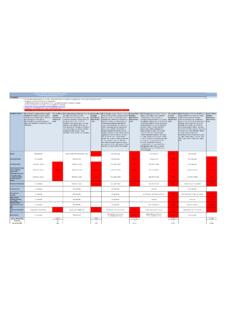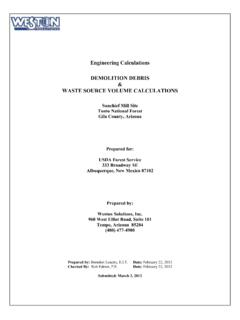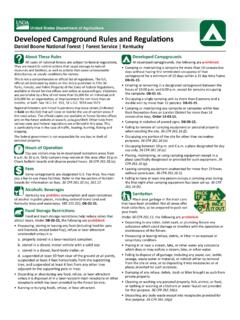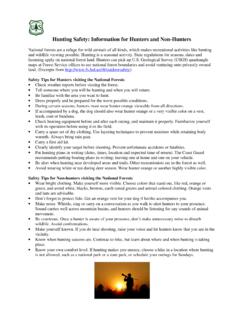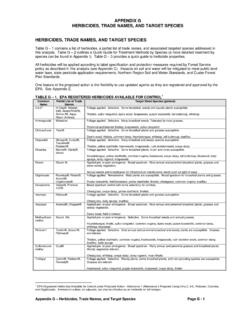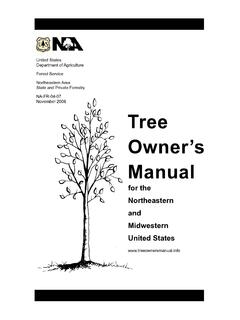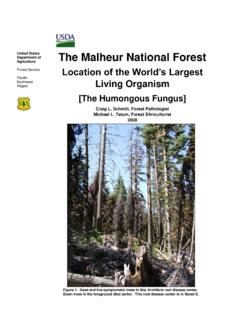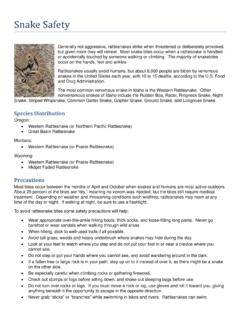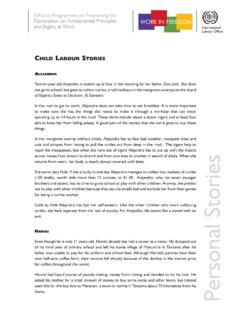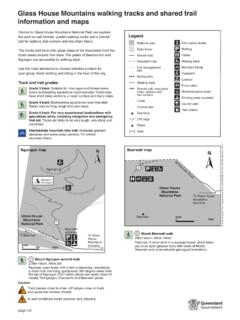Transcription of The Great Fire of 1910 - USDA
1 The Great Fire of 1910 The Great Fire of 1910 Contents A. The Great Fire B. Synopsis C. Blowup Description by Tim Egan D. Map The Great Fire of 1910 The Fire No official cause was ever listed for the 1910 fire. But 1910 was also the driest year in anyone's memory. Snows melted early and the spring rains never came. By June, the woods were on fire in a hundred different places. Loggers, homesteaders and campers started some of the blazes accidentally. Others were thought to be the work of arsonists, possibly transient firefighters trying to insure future employment. However, it appears the largest single contributor was the newly constructed Chicago, Milwaukee and Puget Sound Railway, which followed the St Joe River east from St. Maries to Avery, Idaho. It then disappeared into the densely timbered Bitterroot Mountains, emerging again near Taft, Montana. In a 1911 report, a supervisor on the Coeur d'Alene National Forest estimated more than 100 fires were started by coal-powered locomotives that frequently spewed red-hot cinders into tinder-dry forests.
2 The railroad hired spotters to walk the tracks and douse flare-ups, but as summer wore on the inevitable drew near. By August, normally swift-running rivers had slowed to a crawl and many streams had simply disappeared into bedrock. A bad electrical storm the night of July 15 touched off a large number of fires in North Idaho. It was one of the largest forest fires in American history. Maybe even one of the largest forest fire ever anywhere in the world. No one knows for sure, but even now, it is hard to put into words what it did. For two terrifying days and night's - August 20 and 21, 1910 - the fire raged across three million acres of virgin timberland in northern Idaho and western Montana. Many thought the world would end, and for 86 fire victims, it did. Most of what was destroyed fell to hurricane-force winds that turned the fire into a blowtorch. Re-constructing what happened, leads to an almost impossible conclusion: Most of the devastation occurred in a six-hour period.
3 A forester wrote of flames shooting hundreds of feet in the air, "fanned by a tornadic wind so violent that the flames flattened out ahead, swooping to earth in Great darting curves, truly a veritable red demon from hell." Depending on who was doing the counting, there were either 1,736 fires burning in northern Idaho and western Montana on August 19, or there were 3,000. Most of the fires were under control. Then, on Saturday afternoon, August 20, all hell broke lose. Hurricane-force winds, unlike anything seen since, roared across the rolling country of eastern Washington. Then on into Idaho and Montana forests that were so dry they crackled underfoot. In a matter of hours, fires became firestorms, and trees by the millions became exploding candles. Millions more trees, sucked from the ground, roots and all, became flying blowtorches. It was dark by four in the afternoon, save for wind-powered fireballs that rolled from ridge top to ridge top at seventy miles an hour.
4 They leaped canyons a half-mile wide in one fluid motion. Entire mountainsides ignited in an instant. "The fire turned trees into weird torches that exploded like Roman candles," one survivor told a reporter. It was like nothing anyone had ever seen before. By noon on the twenty-first, daylight was dark as far north as Saskatoon, Canada, as far south as Denver, and as far east as Watertown, New York. To the west, the sky was so filled with smoke, ships 500 miles at sea could not navigate by the stars. Smoke turned the sun an eerie copper color in Boston. Soot fell on the ice in Greenland. After August 22, the winds slowed and temperatures dropped. On the night of the 23rd, a general light rain, with snow in the higher elevations eventually checked the flames. The Aftermath Eighty-six people died in the Big Blowup, most were fire fighters on the front lines of the fire. Hundreds more survived, many by the grace of God. Ranger Edward Pulaski, led men with prayers on their lips through a pitch-black darkness punctuated by exploding trees and waves of flames that arced across the night sky.
5 Pulaski saved most of his 45-man crew in a mine portal in a narrow canyon over taken by a firestorm on all sides. The Great Fire of 1910 burned three million acres and killed enough timber to fill a freight train 2,400 miles long. Merchantable timber destroyed was estimated to be eight billion board feet, or enough wood to build 800,000 houses. 20 million acres were burned across the entire Northwest Entire towns were destroyed. Wallace, Idaho was in the direct path of the raging fire. Citizens, mostly women and children , boarded trains to evacuate the threatened town. Others stayed and sprinkled roofs with hoses. Firemen patrolled the city and awaited the inevitable. Smoking embers began falling in town and by 4 o clock the dark. Smoky sky triggered the city street lamps. It was unmistakable to all that the town would burn, somehow, somewhere. Townsfolk heard a roar like the the sound of a storm at sea. Another described the sound like a thousand trains going over a thousand steel trestles.
6 The mayor marshaled volunteers and busily fought fires throughout the city. Sunday dawned dark and stayed that way. The hillsides were blackened and a third of town was a smoldering fire pit. The entire east end of the town of Wallace was burned down. In some brick buildings only the walls were left standing, while nothing was left of the wood buildings. Of the furniture there was nothing left but the iron and steel parts, and those were sadly out of shape. All glassware was melted. Apples were baked on the trees. In all directions there was nothing left but the burning stumps of once-beautiful trees. The downed monarchs of the forest, fallen to the ground, fed the fire along its entire length. There were hot ash-heaps where trees had criss-crossed in failing and met hot destruction together. Appalling desolation was everywhere. The Great Fire of 1910 burned its way into the American conscience as no other fire had done. "Not ever before had a forest fire been given headlines so big or so black," "It managed to burn its way through public indifference and emerged as a charred but positive landmark along the road to forest protection.
7 " There is no complete record of how much dead timber was salvaged. The best estimate is about 300 million board feet, less than 10 percent of what was killed. It took years to clear away dead timber that clogged trails. A CCC crew in the 1930s recalled walking across narrow canyons on the backs of huge logs left behind by winds. The winds were so powerful that trees were sucked from the ground, roots and all, and tossed into the bottoms of canyons. In one place he estimated the wreckage was 50 feet deep, with a creek running beneath it. Erosion was also a problem. "The fall rains brought down a vast amount of sheet erosion and many steep gullies were scoured out to bedrock." To make matters worse, "nearly all of the scorched trees were immediately attacked by bark beetles." The fire fundamentally shaped Forest Service practices. The Great Fire of 1910 affected forest fire fighting policy of the nation and influenced forest management to this very day. The Great Fire of 1910 Synopsis The FIRE It was one of the largest forest fires in American history.
8 But 1910 was the driest year in anyone's memory Loggers, homesteaders and campers started some of the blazes accidentally. The largest single contributor was the railroads. It was estimated that more than 100 fires were started by coal-powered locomotives. A bad electrical storm the night of July 15 touched off a large number of fires. For two terrifying days and night's - August 20 and 21, 1910 - the fire raged across three million acres of virgin timberland in northern Idaho and western Montana. Most of what was destroyed fell to hurricane-force winds that turned the fire into a blowtorch. A forester wrote of flames shooting hundreds of feet in the air. In a matter of hours, fires became firestorms, and trees by the millions became exploding candles. Millions more trees, sucked from the ground, roots and all, became flying blowtorches. Fireballs leaped canyons a half-mile wide in one fluid motion. Entire mountainsides ignited in an instant.
9 By noon on the twenty-first, daylight was dark as far north as Saskatoon, Canada, as far south as Denver, and as far east as Watertown, New York. The AFTERMATH Eighty-six people died in the Big Blowup, most were fire fighters on the front lines of the fire. Ranger Edward Pulaski, led men to the relative safety of a mine tunnel. The fire turned trees into weird torches that exploded like Roman candles. The 1910 fire burned three million acres and killed enough timber to fill a freight train 2,400 miles long. Wallace, Idaho was in the direct path of the raging fire. Citizens, mostly women and children , boarded trains to evacuate the threatened town. The entire east end of the town of Wallace was burned down. Appalling desolation was everywhere. The Great Fire of 1910 burned its way into the American conscience as no other fire had done. The best estimate of timber salvaged was about 300 million board feet, less than 10 percent of what was killed.
10 Erosion was also a problem. The Great Fire of 1910 affected forest fire fighting policy of the nation and influenced forest management to this very day. Blowup from The Big Burn by Timothy Egan, pp. 154-157 (Chapter 10) A wind out of the American West that tumbles in rollercoaster fashion is known as a Palouser, a Sahaptin Indian word that sounds poetic, named for the lilt of hills at the far eastern edge of Washington State, one of the most productive wheat-growing regions in the world. The skin of that land is lovely, stroked by easy breezes and nourished by soft rains in the spring. But the Palouse is one of those curious places in the West where a weather system can form benign and transform into something ferocious long after it has left the cradle of its creation. On one side is a desert, a high plateau that gets less rain than Phoenix in some years. On the other side are the well-watered forests of Idaho and Montana, with cooler air and steady moisture.
